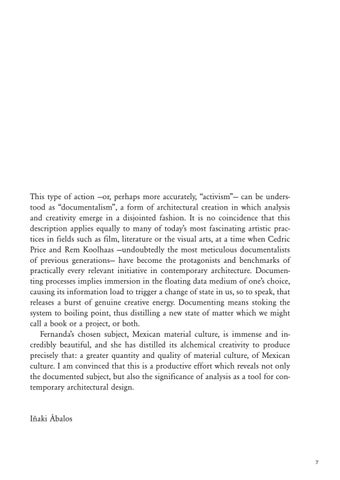This type of action —or, perhaps more accurately, “activism”— can be understood as “documentalism”, a form of architectural creation in which analysis and creativity emerge in a disjointed fashion. It is no coincidence that this description applies equally to many of today’s most fascinating artistic practices in fields such as film, literature or the visual arts, at a time when Cedric Price and Rem Koolhaas —undoubtedly the most meticulous documentalists of previous generations— have become the protagonists and benchmarks of practically every relevant initiative in contemporary architecture. Documenting processes implies immersion in the floating data medium of one’s choice, causing its information load to trigger a change of state in us, so to speak, that releases a burst of genuine creative energy. Documenting means stoking the system to boiling point, thus distilling a new state of matter which we might call a book or a project, or both. Fernanda’s chosen subject, Mexican material culture, is immense and incredibly beautiful, and she has distilled its alchemical creativity to produce precisely that: a greater quantity and quality of material culture, of Mexican culture. I am convinced that this is a productive effort which reveals not only the documented subject, but also the significance of analysis as a tool for contemporary architectural design.
Iñaki Ábalos
7
